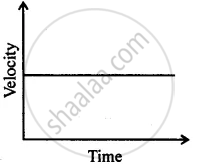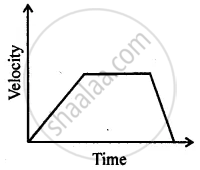Advertisements
Advertisements
Question
A car acquire a velocity of 72 km per hour in 10 second starting from rest. Find
(1) the acceleration,
(2) the average velocity, and
(3) the distance travelled in this time.
Solution
We have the following information,
Initial velocity, (u) = 0 m/s
Final velocity
`(v)` = 72 km/hr
= `"72(1000)"/3600` m/s
= 20 m/s
Time taken , (t) = (10) s
(i) So acceleration,
`a = (v-u)/t`
Put the values in the above equation to get the value of acceleration
`a = (20-0)/10`
= 2 `"m/s"^2`
(ii) we have to find the average velocity. we will use the following relation,
Average velocity = `"Initial velocity + Final velocity"/2`
So , Average velocity = `(v+u)/2`
Therefore putting the value in the above to get the avearge velocity ,
Average velocity = `(20+0)/2` m/s
= 10 m/s
(iii) We have to calculate the distance travelled. We will use the relation,
Distance travelled = (Average velocity) (Time)
So distance travelled is,
= (10)(10) m
= 100 m
APPEARS IN
RELATED QUESTIONS
A bus decreases its speed from 80 km h−1 to 60 km h−1 in 5 s. Find the acceleration of the bus.
A train travelling at 20 m s-1 accelerates at 0.5 m s-2 for 30 s. How far will it travel in this time ?
A boy is sitting on a merry-go-round which is moving with a constant speed of 10 m s−1. This means that the boy is :
Define velocity. State its unit.
Derive the following equations for uniformly accelerated motion:
(i) v = u + at
(ii) `"S = ut" + 1/2 "at"^2`
(iii) v2 = u2 + 2aS
where the symbols have their usual meanings.
Can you suggest a real-life example about the motion of a body from the following velocity – time graph?

Can you suggest a real-life example about the motion of a body from the following velocity – time graph?

A packet is dropped from a stationary helicopter, hovering at a height ‘h’ from ground level, reaches the ground in 12s. Calculate
- the value of h
- final velocity of packet on reaching the ground. (Take g = 9.8 ms−2)
A stone thrown vertically upwards takes 3 s to attain maximum height. Calculate
- initial velocity of the stone
- maximum height attained by the stone. (Take g = 9.8 ms−2)
An object starting from rest travels 20 m in the first 2 s and 160 m in the next 4 s. What will be the velocity after 7 s from the start?
